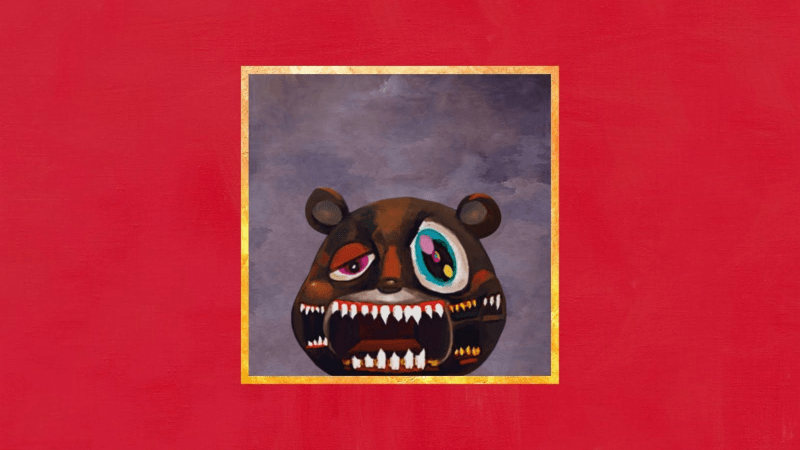November marks the 10th anniversary of what many consider to be Kanye West’s magnum opus and the greatest hip-hop album ever produced — “My Beautiful Dark Twisted Fantasy” (MBDTF). Ever since, Kanye has gone on to perfect his musical craft by experimenting with the harsh drums and tones of “Yeezus,” the critically acclaimed psychedelic, out-of-this-world vibe of “Kids See Ghosts” and even gospel music in his most recent project, “Jesus Is King.”
But enough about the new Kanye. Let’s talk about the old Kanye — the dark, twisted and introspective Kanye.
The album’s cover immediately catches the eye, with its lewd depiction of Kanye entangled with a winged woman. Artist George Condo designed five different covers, but Kanye eventually had to censor the first cover so streaming services didn’t find it as offensive and provocative.
Upon first listen, a few things will immediately stand out about MBDTF — the maximalist production, the samples, the features and, most important, the narrative. MBDTF is peak Kanye storytelling, where he meshes together some of the most prominent voices in hip-hop to address some of the pressing issues on his mind.
In the hedonistic “Dark Fantasy,” he addresses celebrity worship and the complacency plaguing society with the advent of technology.
“Beyond the truest, hey, teacher, teacher/ Tell me how do you respond to students?/ And refresh the page and restart the memory?/ Re-spark the soul and rebuild the energy,” he says.
In the very next track, “Gorgeous,” Kanye asks, “Is hip-hop just a euphemism for a new religion?” The messaging behind this seemingly shallow metaphor is significant — Kanye himself is using hip-hop as a tool to speak to and inspire the Black youth. Since hip-hop’s inception, the genre has been a powerful platform for evocative expression by Black artists on social issues ranging from police brutality to stigmas around mental illnesses.
The album takes a more personal turn with “Blame Game,” where Kanye raps about his split with ex-girlfriend Amber Rose and the arguments they had. In the sketch featuring Chris Rock and Salma Kenas at the end of the song, Salma Kenas’s character butt-dials him and Kanye is forced to listen as his imaginary girlfriend flirts with another man.
Throughout the rest of the album, Kanye’s trademark versatility and confidence in himself is in full display — every track is a masterpiece, with seamless transitions and no song left feeling like unnecessary filler. From the club hit “All Of The Lights,” to melodic rap in “Lost In The World,” Kanye refuses to let MBDTF be defined by a single style.
Highlights and fan favorites throughout the album include the iconic and succinct staccato of a piano on “Runaway,” Mike Dean’s legendary guitar solo in “Devil In A New Dress” and Nicki Minaj’s hard-hitting verse on “Monster” that propelled her to stardom.
However impressive the artistic elements of MBDTF may be, the album’s cultural significance and impact is unparalleled by any other contemporary artwork.
To Kanye, MBDTF was more than just a throwaway album — it was a career-defining moment that would either solidify his legendary status or cast him away into the abyss of forgotten names in hip-hop.
The stakes couldn’t have been higher. In 2009, Kanye came under heavy fire from the media and the public for his infamous interruption of Taylor Swift’s BET award for Best Music Video.
“Yo, Taylor, I’m really happy for you. I’mma let you finish, but Beyoncé had one of the best videos of all time,” he said.
Seeking refuge from the glaring eye of the media, Kanye self-exiled for months in Honolulu’s Avex Recording Studio to produce MBDTF. He flew dozens of notable artists and producers down to Hawaii to work on the album. The artists’ daily routine was grueling, with up to 12 hours spent in the studio a day, along with charitable community work and recreational time.
“They get up every morning to eat breakfast,” producer RZA said in an interview with the Red Bull Music Academy. “They talk about yesterday and the next day and the day of and the present. They plan. Over breakfast, they sit there, they talk about what they want to do, what they did and how to make their music better.”
In addition to the album’s already impressive tracklist, Kanye’s music label GOOD Music had a promotional series of free music releases every Friday throughout the production of the album called GOOD Fridays. Four singles from GOOD Fridays would become tracks on the album, including “Power,” “Monster,” “Devil In a New Dress” and “So Appalled.”
Kanye also directed and starred in a 35-minute long music film titled “Runaway,” which incorporated all of the songs in the album with stunning ivory-themed visuals and garish scenes that bring his music to life.
Upon release, MBDTF was an instant hit, selling 496,000 copies in its first week and debuting at #1 on the Billboard 200. The album went on to win the 2012 Grammy for Best Rap Album and received rave reviews by many critics, including a 94/100 rating from Metacritic based on 45 critic reviews from a range of publications. Billboard also named it the greatest album of the decade.
All in all, MBDTF changed the meta of production hip-hop for the decade that followed. Artists such as J. Cole, Travis Scott and Alicia Keys have sampled his album more than hundreds of times, and notable artists like Kendrick Lamar have cited MBDTF as an artistic inspiration.
On the 10th anniversary of the album’s release, hopefully you can spare an hour and eight minutes out of your day to listen to MBDTF from start to finish, working from Nicki Minaj’s intro narration to Gil Scott-Heron’s sample in an emotional, up-tempo “Who Will Survive In America.”
Contact Ian Park at ianpark3918 ‘at’ gmail.com.
